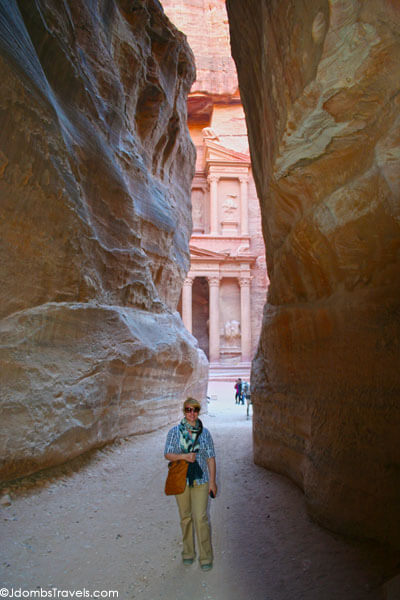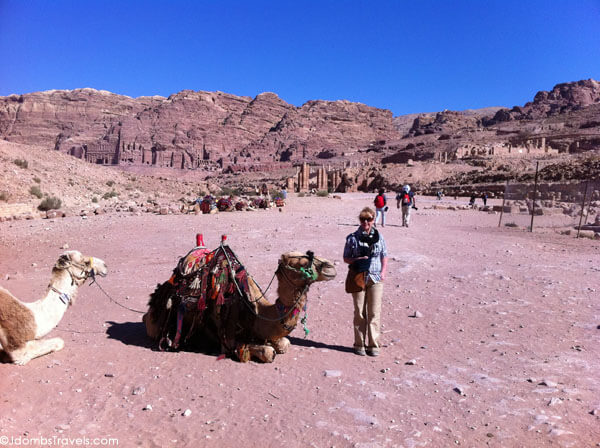
Established sometime around the 6th century BC as the capital city of the Nabataeans, a nomadic tribe who settled in the area and laid the foundations of a commercial empire that extended into Syria, Petra was carved into the red-rose limestone of the Wadi Musa desert. Unlike Jerash, the monuments of Petra are scattered over several miles and nothing prepares you for the sheer size of the city. It simply must be seen to be believed.
A visit to Petra begins with a walk through the Siq, a narrow gorge, over 1km in length, which is flanked on either side by soaring 80 meter high cliffs. As you reach the end of the Siq you catch your first glimpse of Al-Khazneh (the Treasury). This is simply awe inspiring even though you have anxiously been anticipating its view as you trek down the Siq.

While we didn’t want to leave the magnificent Treasury, there is much more to be seen at Petra. Continuing on we reached Facades Street, which is a collection of Nabataean houses, all of which are carved into the rock.
After Facades Street we came to the Main Theater, which dates to the 1st century AD around the time of the rule of King Aretas IV . The theater was carved from the rock in one piece and could seat 6,000 people.

From the Royal Tombs, we walked toward the City Center along the paved street flanked by soaring soaring columns on both sides. This is where the commercial center was. The street leads to the Petra Great Temple, which is currently being excavated by Brown University. The Great Temple is the largest freestanding building yet excavated at Petra measuring over 24,000 square feet.
It felt like we’d been walking for miles at that point, but we began our climb up the 850 winding stone stairs to the Monastery, not without me groaning a bit. For a few Jordanian Dinars, you can take a “Jordanian BMW” (donkey) to the top. We (Tim) opted for the climb. As we climbed, we passed the small stalls of a nearby Bedouin settlement that had set up selling local handicrafts, such as pottery, Bedouin jewelery, and bottles of striated multi-colored sands from the area. About two-thirds of the way up, a Bedouin woman invites us in to her tent for tea and I more than happily hand over a few Dinars for a break and a refreshing drink.
Continuing up the steep stone staircase, the Monastery finally comes into view! The Monastery is beautifully carved, though much less decorated than the Treasury, and so huge that even the doorway is several stories tall. It is similar to design of the Treasury, but it is much larger (50 meters high x 45 meters wide).
We sit at the cave bar for a little while admiring the Monastery while enjoying Bedouin lemon juice with mint. As we sit, we notice that men are climbing up into the massive doorway to enter the Monastery. I couldn’t quite make the climb, but Tim did. Some Bedouins found a bit a shade and relaxed while others played little guitars and danced.
On the way back down, we took our time entering small caves and admiring the monuments again as the shift in the sunlight makes their colors striking in different shades of red-rose.

Know Before You Go
- Petra and the Visitor Center is open 6am – 6pm daily in summer and 6am – 4pm daily in winter.
- Entry for a 1-day ticket is 50 JD for visitors staying at least 1 night in Jordan or 90 JD for visitors on day trip tours.

You can see all the UNESCO World Heritage Sites we’ve visited here.










Ambika says
Great write up Jen. Gald you & Tim had a great time there.Petra is one of those place that I want to visit.
– Ambika
Arianwen says
Great photos! I’d love to see Petra, despite those aggressive camels!
Jennifer Dombrowski says
Too funny, Ari! Apparently I was invading the camels personal space and they let me know it. Petra is beautiful and way bigger than we had anticipated even reading up on it ahead of our trip.
Clark says
Enjoyed your pictures. Do you have a DVD of the section? My brother-in-law is a retired minister and took several tours of the Holy Land and celebrated 60 years in the ministry and is retired now. If you have DVD’s for sale, please let know so I can purchase one for him for his own personal library/museum.